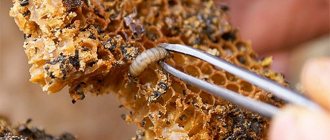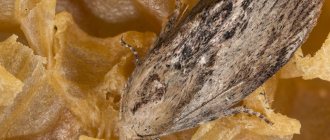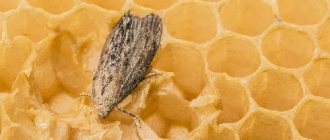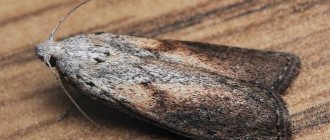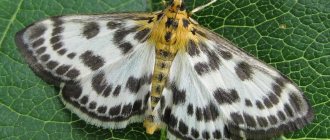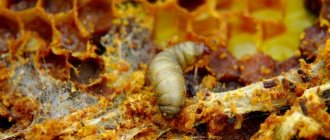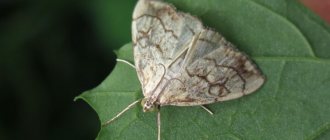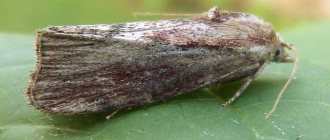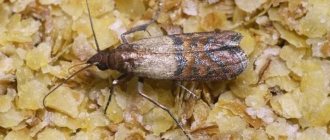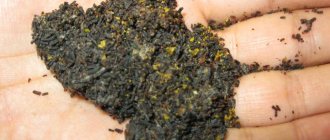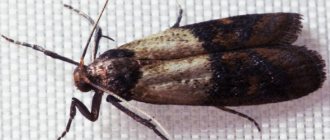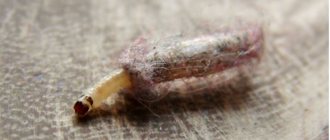Wax moth or bee moth is a pest that poses a threat to beekeepers. This insect lives and breeds in hives. The most dangerous are the larvae that destroy bee products. To prepare the medicine, insects are collected at the initial stage of development. They have a positive effect on the body due to a large number of beneficial substances. For this reason, larvae are used to treat various diseases.
Wax moth is a dangerous pest that parasitizes bee hives.
Bee moth
Bee moth (wax moth) is one of the most malicious pests that penetrate the hive. To protect themselves, they even developed a special mechanism - a smell that imitates the smell of the family. And although the bees try to fight by throwing butterflies out of the hive and sealing or eating larvae, when darkness falls, this activity stops. Little workers at night are engaged in an important process - evaporating moisture from honey. After sitting motionless for a day, the hatched butterflies remaining in the hive begin to lay eggs.
The wax moth larva during its development (about 30 days) is capable of destroying up to 600 honeycombs. This amounts to about 2 g of wax by weight. And one generation of larvae can spoil up to 20 kg of honeycomb. Moreover, everything that gets in the way is destroyed - honey, bee bread, bee larvae.
What is PZHVM?
The waste product of the wax moth is a biological substance that can be obtained thanks to this insect, which is also called the bee moth. It is considered a source of a wide variety of waste products. At the same time, the wax moth itself is considered a pest that threatens beekeeping quite seriously.
You can tell that a bee's home has been attacked by wax moths by looking at the wax on the honeycomb cones, which has been chewed. The main evidence of the penetration of this insect is precisely those excrement. The waste products of wax moths are miniature black pellets that look like poppy seeds. This excrement in the hive remains from the larvae that the wax moth lays.
These creatures are very voracious, capable of actively destroying honey, attacking baby bees and gnawing wax. In this regard, beekeepers consider moths primarily to be dangerous pests, and only then can they be considered as a source of useful and healing products of natural origin.
Few beekeepers breed moths specifically to produce excrement. However, there are still such people. True, because of human disgust, they prefer to call this substance veiledly, often with the same abbreviation PZhVM - waste products of wax moths.
Honey moth: medicinal properties
Some beekeepers do not even realize that the biggest pest in the apiary is a source of unique healing power. Eating honey, beebread and, most importantly, wax, the larvae saturate their body with valuable enzymes. And when processing wax, they use essential amino acids (valine, leucine, isoleucine), which are necessary for a person to function normally.
The tincture prepared from bee moth larvae contains 20 of the 28 free amino acids. Moreover, 9 of them are essential, that is, they are not synthesized by the human body.
In addition, the three above-mentioned amino acids are a source for the synthesis of alanine, an amino acid that regulates higher nervous activity and is responsible for the normalization of metabolic processes. Even in the synthesis of glucose, alanine can be used as a raw material if necessary.
Preparations based on bee moth larvae have a number of therapeutic effects when used:
- Antimicrobial (viruses, bacteria, protozoa, fungi);
- Immunostimulating and regulating metabolism;
- Absorbable in case of scar formation: myocardial infarction, secondary female infertility, gastric or duodenal ulcer;
- Normalizing in relation to the vascular system. At the same time, the risk of blood clots is reduced, blood microcirculation improves, blood pressure and hemoglobin levels return to normal;
- Restoring the nervous system, especially during rehabilitation after cerebrovascular accident;
- Cleansing for damage to the body by radioactive radiation and various types of toxic poisoning, including alcoholic ones;
- Regenerating, if necessary, recovery after surgical interventions, as well as restoring after serious diseases, including infectious ones;
- Regulating in case of disruptions in hormonal processes during pregnancy, menopause or in the treatment of impotence.
Important! The healing properties of preparations from moth larvae were known back in ancient Egypt, where the “elixir of youth” was prepared from the caterpillars, which slowed down aging. Studies by numerous scientists (I. I. Mechnikov, his students S. I. Metalnikov and I. S. Zolotarev, doctor S. A. Mukhin, professor A. A. Nikulin) have proven that the presence of the cerrase enzyme in the digestive tract of caterpillars makes it possible wax processing. It is this ingredient, turning into a medicine, that dissolves the durable shell of Koch's bacillus spores, making it available for destruction.
Side effects contraindications for use
Although bee moth tincture has many beneficial properties, it should not always be used. In certain cases, bee moth extracts should not be used. Such cases include:
- Pregnancy and lactation period.
- Children under 14 years of age.
- People who have inflammation of the gastrointestinal tract.
- If you are allergic to certain components.
- In case of individual intolerance to certain components of the tincture or ointment.
Although side effects are uncommon, some people experience them. Among the negative consequences are:
- Occasional dizziness or headache.
- Vomiting or nausea.
- Problems with appetite and sleep.
- Disruption of the gastrointestinal tract.
It is in folk medicine that an ointment or tincture based on insect larvae is actively used. After all, bee moths can improve the functioning of various systems. With the help of the extract, people solve problems associated with sleep and lethargy.
Tincture of larvae: treatment of tuberculosis
The medicinal effect of the tincture was used long before official recognition. These were mainly pulmonary diseases and, in particular, tuberculosis. Under the influence of the drug, the following processes are launched:
- Enhanced growth of healthy cells, as a result of which damaged tissues are quickly replaced by new ones;
- Increasing the body's defenses and resistance to tuberculosis infection;
- Suppressing the resistance of mycobacteria to medications and, as a result, enhancing the therapeutic effect;
- Elimination of fungal infection - the most common complication when using chemicals;
- Effective removal of decay products of microbial activity, which is facilitated by the content of aspartic acid in the medicine.
Important! In addition, wax moth tincture is used to treat tuberculosis of the nervous system, digestive tract, joints, skin, meninges, and genitourinary organs.
Bee moth tincture: application
There are no verified results of clinical trials for the tincture, and official medicine so far only recognizes the effect against tuberculosis. However, studies of the chemical composition and the presence of a wide range of valuable components in the preparation suggest healing properties for a number of other pathological conditions. And this is confirmed by numerous user reviews.
Today, preparations from wax moth larvae are used to treat:
- Oncological diseases;
- Atherosclerotic changes;
- Varicose veins;
- Disturbances in the functioning of the nervous system;
- Prostatitis, impotence, infertility;
- Normalization of blood sugar;
- Diseases of the digestive tract: ulcers, gastritis, colitis, pancreatitis, cholecystitis;
- Cardiac pathologies.
Important! Preparations made from larvae are compatible with almost all medications and do not have a toxic effect. Using them together with medications helps the body absorb chemical components much more efficiently and quickly get rid of toxins. Thus, the therapeutic effect is enhanced many times over.
Official medicine data
The opinion of official medicine regarding the effectiveness and safety of the medicine is contradictory: WHO does not want to recognize the tincture and its healing properties as an effective method of therapy. This is quite justified, because there is no statistical data regarding confirmation of effectiveness. The enzyme due to which the tincture has such value does not exist in the field of biochemistry, and scientific research was carried out by one private practitioner who is not known to the world. All that remains is to trust the people who have experienced similar therapeutic measures on themselves and were satisfied with the result. The medicinal properties of the composition remain in doubt, however, in practice there are many cases where people managed to get rid of ailments through the use of this folk remedy.
Preparation of wax moth tincture
Both bee moth larvae and their metabolic products can be used to make medicine. Preparation of the drug from larvae can be carried out in several ways:
- Tincture. Take 5 g of larvae up to 10 days of age (size - up to 1.5 cm) and fill them with 70% alcohol in a dark glass container. Infuse for 1-1.5 weeks with daily shaking. Used for treatment after careful straining;
- Hood. To make the product, place a glass of larvae in a liter of vodka. This mixture has been infused for 2-2.5 weeks with constant shaking and also in a dark place;
- Ointment. Used for external treatment. To do this, 50 g of larvae are poured with alcohol so that it only slightly covers them. Place in a dark place for 5 days, then add 200 g of St. John's wort and calendula oils. 50 g of propolis and wax are added in crushed form to the resulting mixture and placed in a water bath for 2 hours. Be sure to stir during cooking. Then filter and cool.
However, it often happens that the moth scatters and there are no larvae left. In this case, you can use insect waste products, which also have a healing effect. According to some professionals, this remedy is even more effective (it is used for 300 diseases). Prepare the tincture as follows:
- Crushed waste products are poured with 40% medical alcohol in a ratio of 1:20. The alcohol is diluted with artesian water;
- Leave in a dark place for 1-2 weeks. In this case, biologically active substances are extracted from waste products into the tincture;
- The finished tincture is filtered and poured into a dark glass container. The finished product has the smell of good whiskey without foreign impurities.
Important! The product has high biological activity, so its preparation requires especially careful adherence to dosages and hygiene rules.
Description and characteristics of the insect
People call moths all insects belonging to the order Microlepidoptera.
Adults are similar in appearance to small butterflies, which are mainly nocturnal or crepuscular.
Their powerful jaws help them chew even wood and fruit seeds, and their unpretentiousness in food determines the wide distribution of these pests.
The moth causes greater damage to plants, tissues and products when it is in the caterpillar stage.
Appearance of a moth
Although there are many types of these insects, they are similar in appearance.
The moth has an inconspicuous appearance, the size is 5-9 mm.
Their size does not exceed 5-9 mm. They fly poorly and are dull in color. There are 2 main types of moths living in houses: clothes moths and furniture moths. The first has a light brown color, and the second is gray, but with a quick inspection it is difficult to identify these differences.
Externally, the caterpillars of these insects and other species of butterflies are no different. They rarely exceed 1.5 mm in length, so they are difficult to notice. The larvae are sedentary, love dark places and eat a lot.
How long does he live?
Before becoming adults, these insects go through the egg and larval stages. The caterpillar lives from 3 to 10 months. At this time, it actively feeds and destroys clothing, furniture, food, and forms a cocoon in which its further development occurs.
The life expectancy at all stages of moth formation is about a year.
Where does it live?
Depending on the species, the habitat of insects will be different. Food moths lay eggs in food.
Food moths lay eggs in food.
It can be:
- cereals;
- candies;
- vermicelli;
- cookies, etc.
Furniture moths feed on outerwear made from natural woolen fabrics, fur, etc. They often develop in closets and suitcases where sunlight does not penetrate.
Indoor moths can develop anywhere in the house where there are favorable conditions for it, as well as products made from natural fabrics such as cotton, silk, etc.
In addition, these insects can live on different plants (cabbage, potatoes, poplar, chestnut, wormwood) and harm them. They also live in beehives, where they feed on beebread, honey and wax.
In nature, some types of moths feed on the horny formations of animals and birds. They settle in their burrows or nests. There is a species of moth that lives in the horns of buffalos or antelopes, and in the shells of dead turtles.
Wax moth: treatment
The administration of preparations from wax moth larvae is carried out taking into account the weight of the adult patient or the number of completed years in childhood. Depending on the required therapeutic effect, the following dosages are used (at a concentration of 20%):
- For prevention and strengthening of the immune system: adults – 2 drops for every 10 kg of weight, children under 14 years of age – 1 drop per year of life;
- For diseases of the heart and blood vessels : adults – 3 drops for every 10 kg of weight, children – 1 for every year;
- For tuberculosis: adults - 4 drops for every 10 kg, children - 1 drop for every year of life;
- For oncology: adults – 5 drops per 10 kg of weight, children – 1 for every year;
- For diseases of the genital area: adults – 3 drops for every 10 kg of weight;
- For respiratory diseases: adults – 2.5 drops per 10 kg of weight, children – 1 drop per year of life.
If a 10% tincture is used for treatment, the doses are doubled. Application requires compliance with several requirements:
- Since the drug is a strong biostimulant, treatment should begin by taking 25% of the recommended dose, increasing the dose by another 25% every day. Thus, within 4 days the dose is equal to the recommended amount;
- You can dilute the drops in a small amount of water (70-100 ml). If the drug is taken for prophylactic purposes, you can drink it at once; in other cases, the dose is divided in half;
- The medicine is not recommended to be taken in the evening, as it has a tonic effect;
- The product should not be mixed with food, so take it before meals (30 minutes before) or 1 hour after meals;
- As with honey, the medicine should not be swallowed immediately, but should be kept in the mouth for a little while.
Important! If no side effects are observed during the initial intake, after a few days they proceed to a full two-time intake for 3 months. This is another advantage of the tincture of larvae - after all, most traditional medicines are not taken for more than 30 days without a break.
When purchasing the drug, there may be no instructions. Or you will use a homemade remedy. In this case, the best decision would be to consult your doctor.
Other forms of release
There are several types of preparations based on wax moths on sale:
- tincture;
- ointment;
- tablets, capsules.
Substances in tablet form are taken 1 pc. 2 times a day. The duration of treatment is determined by the doctor. It is not recommended to add other components to improve the taste, for example, sugar, as there is a risk of destroying some of the beneficial substances. For this reason, the medicine is not available in syrup form.
How to avoid counterfeiting
The best option is to find a beekeeper you know and buy from him, if not larvae, then at least wax moth waste products (WWM). If this is not feasible, here are a few tips to help avoid commercial pitfalls:
- To purchase online (and these drugs are not yet sold in pharmacies), choose a beekeeping farm or at least a specialized website. Then the quality guarantees will not be fake;
- This preparation from larvae or PGVM should be packaged in dark glass containers. This is a mandatory condition, since light destroys most active substances, and plastic can react with them;
- If there are larvae at the bottom, then this is a guarantee that this is indeed a wax moth product. By their quantity you can even determine the degree of concentration.
Like any folk remedy, wax moth tincture is not a panacea, but only a means of activating the body’s own powers. Therefore, do not forget to consult your doctor and start taking small doses.
What is PZHVM?
The beekeeping industry has many useful products. The waste product of the wax moth occupies an honorable place in this list. The wax moth is a small moth. The exceptional feature of the small insect lies in its diet. The moth feeds exclusively on bee products - honey and wax, so all nutrients accumulate in its body.
Wax moth excrement is used by traditional healers to treat diseases. The moth flies into the hive at night, finds the largest concentration of bees and lays larvae. In the morning, the moth flies out of the hive and hides in a tree or bush, and at night it returns to the bees to carry out its plan of laying offspring.
After the wax moth lays all the larvae, it stops feeding, since vital processes are supported by accumulated substances.
